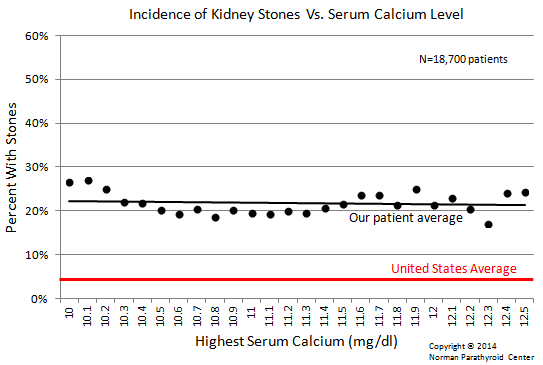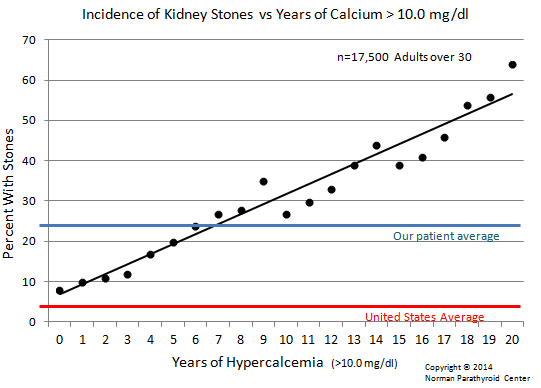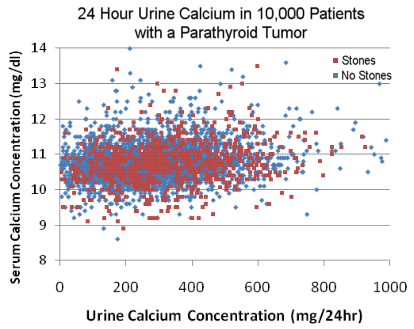What are Kidney Stones?
Kidney stones are small hard stones that form in the kidney because of excess compounds, usually caclium, in the blood. Kidney stones occur in about 5% of the population and are usually made of calcium. Hyperparathyroidism is the number one cause of kidney stones. Every person with a kidney stone should be tested for a problem with their parathyroid glands. Nearly half of all people with kidney stones have a parathyroid tumor in their neck that must be removed or the kidney stones will return. Learn what kidney stones are and what you should do to prevent them from coming back. Most doctors do not do the correct testing of parathyroid glands in patients with kidney stones.
What Causes Kidney Stones?
Kidney stones develop because the kidney is cleaning and filtering the blood of impurities. If you have too much of certain elements in your blood, the kidney will try to correct it and remove the impurities which can collect to form stones if present in high amounts. By far the number one impurity in the blood that the kidney wants to get rid of is excess blood calcium. When there is too much calcium (or other minerals) in the blood, the kidney tries to remove it causing it to collect in the center of the kidney where it clumps together into one or more small stones. It is possible that the stones actually form in the bladder, but almost always, kidney stones form in the kidney (thus their name!). And yes, kidney stones they really do look like small stones.
What are Kidney Stones Made of?
At least 90% of kidney stones are made up of calcium and the number one cause of kidney stones is hyperparathyroidism, a disease caused by a problem with the parathyroid glands. The other 10% of kidney stones are made up of other blood impurities such as uric acid, and other very rare compounds. Kidney stones are discussed on this website because most are made of calcium and the amount of calcium in our bodies is controlled by the parathyroid glands. It is the job of the parathyroid glands to control the amount of calcium in our blood and in our bones. However, about 2 percent of people will develop a problem with their parathyroid glands during their lifetime (this entire website is about parathyroid problems), and all patients with a parathyroid problem will have problems with calcium. Thus, by far the most common cause for kidney stones is hyperparathyroidism--a disease of calcium caused by a tumor on one or two of the parathyroid glands. However, this statement is only true for people who just started having kidney stones, not people who have had many stones for many years.
Kidney stones occur in all people world wide at the same rate: between 3 and 5% of the population. However, in our patients that we operate on for hyperparathyroidism, 38% of men have stones and 20% of women have stones. Thus not everybody with a parathyroid problem will get kidney stones (but they do get other problems!). And likewise, not everybody with kidney stones has a parathyroid problem. However, if you are reading this page because you recently had a kidney stone, you MUST be checked for a parathyroid problem (we will tell you how to do this later on this page). Untreated hyperparathyroidism doesn't just cause kidney stones, it also causes high blood pressure, osteoporosis, fractures, coronary heart disease, atrial fibrillation (heart problems), stroke, renal failure, GERD, and even increases your risk of several cancers. Avoiding more kidney stones is only one small part of why you must be checked for hyperparathyroidism if you have kidney stones. IMPORTANT... do not assume that your doctor is automatically checking you for a parathyroid problem. Less than 20% of doctors (including urologists) check patients for parathyroid problems when they get a kidney stone. So keep reading and make sure you are getting checked correctly. One important fact that must be stated: people with kidney stones due to parathyroid tumors usually don't have lots of kidney stones for many years. Instead, they have one or a couple of stones and they never had them before. This page is written for people who have a new onset of kidney stones, not people who have had dozens of stones for dozens of years. We will discuss this at the bottom of the page.
Four Types of Kidney Stones
There are 4 different kind of kidney stones, shown in the table below. The first two, however, are both generically called "calcium kidney stones" and they differ only in the kind of other mineral that is combined with the calcium. It is not important for you (or your doctor) to distinguish between the two types of calcium kidney stones. They behave the same, the treatment is the same, and they are both caused by a parathyroid problem about half of the time.
| Kidney Stone Type | Percentage of all Stones | Caused by Hyperparathyroidism ? |
|---|---|---|
| Calcium Oxalate kidney stones | 85% | Yes, about half of them |
| Calcium Phosphate kidney stones | 8-10% | Yes, at least 80% of them |
| Uric Acid kidney stones | 5% | No |
| Struvite kidney stones | 2-3% | No |
| Cystine kidney stones | very rare, <0.01% | No |
As you can see, about 95% of people with a kidney stone have a calcium-containing kidney stone. Some of them will have parathyroid disease. Thus, everybody with a kidney stone must be checked for an underlying parathyroid problem so it can be addressed. It is also very important for you to understand that you and your doctor may not know what kind of stone you had. Unless you catch it (or they remove it during surgery), nobody will ever know. Thus, if you don't know what kind of kidney stone you had, then it must be assumed that you had a calcium-kidney stone because 95% of stones are calcium stones. Therefore you should expect that you be checked for hyperparathyroidism (they should also check for blood levels of uric acid to check for uric acid stones, but that is less than 5% of stones). The stones occurring with struvite are due to long-term bladder infections so that doesn't get confused with calcium stones, and cystine stones are a genetic problem that is far too rare to be discussed here.
Why Did You Get Kidney Stones?
If you have kidney stones, you should check your blood calcium level. If your calcium level is high, then you need to get a PTH level checked. Note: The following table and this web page is written for people with NEW ONSET of kidney stones, not people who have had lots of stones for many years.
Blood calcium and parathyroid hormone (PTH) levels:
Did a bad parathyroid gland cause the Kidney Stones?
| Blood Calcium Level |
Parathyroid Hormone PTH (normal range 15-65 pg/ml) |
Hyperparathyroidism Caused the Kidney Stone ? | Group | |
|---|---|---|---|---|
| United States mg/dl |
Canada / Europe mmol/l | |||
| 9.0 - 10.0 | 2.25 - 2.50 | several 35 or below | No | 1 |
| 9.0 - 10.0 | 2.25 - 2.50 | several 35 to 80 | Unlikely | 2 |
| 9.0 - 10.0 | 2.25 - 2.50 | several 80 to 100 | Unlikely | 3 |
| 9.0 - 10.0 | 2.25 - 2.50 | several 90 or above | Possible - check again | 4 |
| 9.5 - 10.5 | 2.37 - 2.62 | several 35 to 80 | Probably- check again | 5 |
| 10.4 - 11.0 | 2.58 - 2.75 | 45 or above | Yes | 6 |
| 10.0 - 10.7 | 2.25 - 2.67 | 55 or above | Yes | 7 |
| 11.0 or above | 2.75 or above | 35 or above | Yes | 8 |
Note, to understand this table, you need to know that one normal blood calcium level means nothing. Almost always you are going to need at least two calcium and two PTH levels. If the blood calcium level is normal, than it must be checked again (because calcium levels go up and down all the time in people with a parathyroid tumor). Thus, the first column is for people who got their blood calcium checked more than once and it was NORMAL, and then they got it checked a second time and it was higher. The first column is for people who had their calcium checked several times. If you had one calcium level and it was high, then you are very close to having the answer---yes, the stone was caused by a parathyroid tumor. Almost always, one high calcium level in a patient with RECENT onset of kidney stones is almost always due to a parathyroid tumor. Remember, the upper limit of normal blood calcium in adults over age 35 is 10.0 mg/dl (2.5 mmol/l). Many labs do not report blood calcium normal ranges according to the patients age, instead showing an upper limit of normal of 10.5 (2.62 mmol/l) which is the upper limit of normal for teenagers. We have an entire page dedicated to the normal range of calcium according to age. Teenagers and twenty-somethings have blood calcium levels that are higher than adults over 35. A calcium level of 10.5 mg/dl is perfectly normal in a teenager, but it is not normal in an adult over 35 years old.
Most people with kidney stones will be in Groups 1, 6, 7, and 8:
- Group 1: multiple normal calcium levels and mutiple parathyroid hormone levels less than 35, it is very unlikely that they have a parathyroid tumor causing their kidney stones.
- Group 6: multiple calcium levels, some in the 9's and some in the 10's, several parathyroid hormone levels above 45. This is a very commonly missed parathyroid/kidney stone group and these patients are overlooked all the time until they get a second or third bout of kidney stones and start needing operations for kidney stones.
- Group 7: multiple calcium levels that are high normal or high, parathyroid hormone levels above 55. This group is also commonly ignored by their doctors until they get a second or third bout of stones. Then everybody is kicking themselves in the butt for missing the obvious parathyroid tumor that should have been removed years earlier.
- Group 8: blood calcium levels above 11.0 mg/dl and PTH levels above 35. This should be very easy for any doctor to know, although the "normal" PTH level confuses many doctors. When the calcium is always high, the PTH shouldn't be "normal", it should be low. Even if the PTH levels are not checked, blood calcium levels of 11.0 mg/dl and a kidney stone means primary hyperparathyroidism virtually 100% of the time.
Also note that this kidney stone/parathyroid table has a different normal range for blood calcium levels in the US compared to most other countries. This is because the US measures calcium in different units than most other countries. This is like measuring distance in miles or kilometers. It doesn't matter; it is still measuring distance, or in the case of calcium, the concentration of calcium in the blood. Always get a copy of your lab results: the units are always right on the report.
Measuring just blood calcium may not be enough
to rule out hyperparathyroidism as cause of kidney stones.
Many doctors will not measure parathyroid hormone levels to check to see if you have a parathyroid tumor as the cause of the kidney stones. They will see that your calcium "is normal", or "just a little bit high" and assume (incorrectly) that a parathyroid tumor is not the cause of the kidney stones. For these reasons, measuring blood calcium alone is not adequate to determine if a patient with stones has hyperparathyroidism or not:
- Calcium levels in patients with primary hyperparathyroidism are variable. Most people with a parathyroid tumor (which must be removed)have calcium levels that go up and down, high sometimes and normal occasionally. Thus, if your doctor measures your calcium one time after a kidney stone and says "your calcium was normal, so you don't have a parathyroid tumor as the cause" you may want to check that calcium again. You cannot determine if somebody has a parathyroid tumor by measuring ONE blood calcium level. If the calcium is high, then cool--we figure it out. If the calcium is normal, then that doesn't mean a thing, it must be measured again, and the PTH must be measured. Said differently: one high calcium and new onset of kidney stones--> its hyperparathyroidism. One normal blood calcium and new onset of kidney stones--> we don't know and additional calcium levels must be measured and parathyroid hormone (PTH) levels must be measured.
- Labs do not report blood calcium normal ranges according to the patient's age. We have an entire page on this topic, but the bottom line is that it is almost never normal for adults over age 35 to have blood calcium levels over 10.0 mg/dl (2.5 mmol/l in Canada and Europe). If you have blood calcium levels of 10.0 mg/dl or higher and you have a kidney stone, you have greater than 90% chance that you have a parathyroid tumor as the cause. The problem is that most labs will report a normal range of 10.5 mg/dl (2.62 mmol/l) which is normal for teenagers, but not normal for adults over age 35. Be careful of the normal range on your labs! Adults should have calcium levels "in the 9's". We have a Hypercalcemia Calculator, that will tell you the exact normal range of blood calcium for you. Try it!
Kidney Stones and Hyperparathyroidism
Kidney stones occur in about 4% of people, but are much more common in people with blood calcium levels over 10.0 mg/dl (the upper limit of normal for adults over age 35). It is VERY important to understand that the chances of getting kidney stones are NOT higher if your blood calcium goes higher. Said differently, a calcium of 12 does not give you higher chances of getting kidney stones than a calcium of 11. Many doctors don't understand this and say "your calcium isn't that high, we can just watch it for now until it gets higher". That presumes that a very high calcium level is more dangerous than a mildly elevated calcium level--and it is not. Very mild elevations of blood calcium are just as dangerous as very high elevations of calcium. The graph below is from 18,700 of our patients that we operated on for primary hyperparathyroidism. It shows the occurrence of kidney stones according to how high the blood calcium is. The red line shows that about 4% of all humans get kidney stones. However, the black line shows that 22.5% of patients with hyperparathyroidism get kidney stones. The important thing for you to see (and teach your doctor), is that the incidence of stones does not go up as the blood calcium goes higher. That is, a calcium of 12.5 mg/dl does not have a higher incidence of kidney stones than a calcium of 10.5 mg/dl.

It's all about duration! How long has the calcium been high?
This next graph shows the same patients but this time we graphed them according to how long their calcium was above 10.0 mg/dl (the upper limit of normal for adults over age 35) (2.51 mmol/l for our European and Canadian friends). So this time the bottom X axis is the number of years their calcium has been above 10.0 instead of how high the blood calcium was in the previous graph. You can see that the longer a person has high calcium the higher the chance of getting kidney stones. Even very mild elevations of calcium for a few years dramatically increases the incidence of kidney stones.

Kidney Failure
One thing that we are not showing on these graphs is that the function of the kidney (how good it works to filter and clean the blood) decreases over time also. Not only do patients get kidney stones when they have high calcium for a few years, they also begin to develop kidney failure. About half of all patients who have blood calcium levels even a little bit high for 10 years will begin to get a decrease in GFR, the number we use to determine the health of the kidney. By 15 years of even mild high calcium, 80% of patients will have some renal failure, usually it is Stage III kidney failure at this time. We have a blog discussing kidney failure and stones which includes x-rays and pictures.
Men vs Women; Young vs Old.
Men get kidney stones twice as often as women. This is true of all kidney stones, whether they are caused by a parathyroid tumor or not. The incidence of stones increases with age, with the peak being around 60 years of age. Wow, guess what, the incidence of hyperparathyroidism increases with age, with the peak incidence being at age 60.
24 Hour Urine Test for Urine Calcium Levels
There is a test to measure the amount of calcium in your urine. This is almost always done by having you collect your pee in a jug for 24 hours and keeping that jug in your refrigerator the entire time (disgusting!). This test is supposed to tell your doctors if you have too much calcium in your urine, and from this they are supposed to tell you if you are at risk for more stones. The concept being that people with higher calcium in their kidneys are more likely to get kidney stones. Unfortunately, it isn't that simple and this test is pretty worthless. Let's take a look at the 24-Hour-Urine results for 10,000 of our patients who had hyperparathyroidism. This graph shows the amount of calcium along the bottom X axis from a low near zero up to 1000 mg/24 hours (extremely high). The normal range is less than 350, but you can see that most patients with hyperparathyroidism have urine calcium that is in the normal range. We then made every patient with kidney stones have a red dot, and those that never had a kidney stone have a blue dot. And guess what, they are exactly the same. The amount of calcium in the urine is the same for those with kidney stones and those without kidney stones.

If the amount of calcium in the urine had an influence on the formation of kidney stones in people with a parathyroid tumor, then all the blue dots (no stones) would be on the left side of the graph (low urine calcium levels) and all the red dots (do have stones) would be on the right side of the graph (high urine calcium). But this is not the case. The red and the blue dots are distributed equally along the x-axis. Thus, a 24 hour urine test cannot be used to determine which patient with high blood calcium or hyperparathyroidism is at risk of getting a kidney stone. So if your doctor wants to do this test for you (and tells you to keep your pee in the refrigerator for a few days--UGH), you may want to take this page to them and show them that we can't tell who will and will not get stones by how much calcium is in the urine.
As a review from above, even mildly elevated calcium in the BLOOD will dramatically increase your risk of kidney stones (and many other problems), with the risk being related to the duration of high calcium (how many years above 10.0 mg/dl), and not related at all to how HIGH the blood calcium is in the BLOOD or in the urine.
Signs that a parathyroid tumor is NOT causing your kidney stones.
We've seen thousands upon thousands of people with kidney stones due to hyperparathyroidism. We have found a couple of things that are important for you and your doctor to know. The typical patient with stones due to hyperparathyroidism has had one or two stones. Often it is one or two attacks, but the urologist says there are more inside. Usually these people have never had a kidney stone before. The kidney stone problem is new. This is in distinct contrast to people who say "I've had 35 kidney stones over the past 20 years", because that is usually a kidney problem, not a parathyroid problem. Sure it is possible that you had kidney stones when you were 25 that weren't due to a parathyroid problem... and now 40 years later you get another kidney stone attack that is due to a parathyroid tumor. We see this frequently and this is classic for a parathyroid tumor--the first stone was not related to parathyroid problems, and the second one many years later was.
This page is written for a person who never had stones, or had a stone decades ago, and now has a new stone that is causing problems. That person has about a 50% chance that a parathyroid tumor is causing the new stone problem. If you have lots of stones for many years, then it is possible, but unlikely that a parathyroid problem is the cause, and instead you almost surely have a kidney problem as the cause. Please folks, if you have had dozens of stones over many years, don't call us (or any doctor for that matter) and demand to have your parathyroid tumor removed. Lots of kidney stones over many years are almost never caused by a parathyroid problem. Please do not ask for a consult with us and then tell us you have had stones for year. We will put our hair out. Hyperparathyroidism causes NEW onset of stones in people who don't otherwise have stones. Yes, it is possible that you are a stone former for many years, and THEN you got a new parathyroid problem. (yes it is true that you can have diabetes and then break your arm--the two are unrelated).
What to read next
- If you want to read more about calcium levels in the blood, how to diagnose parathyroid disease, and look at a graph of normal and high calcium levels, then go to our page on Diagnosing Parathyroid Disease. This page has some very nice graphs. Remember, an expert surgeon should be able to fix this problem in about 20 minutes or less, but make sure the surgeon examines all four parathyroid glands--30% will have more than one bad parathyroid gland.
- The normal range for blood calcium changes as we go through life. We have an entire page looking at the normal range for people of different ages. Very good information!
- The best page of this website is the page that describes the video of our doctors performing a complete parathyroid operation, removing two parathyroid tumors--all in less than 13 minutes. This is a very popular video.
- How to become our patient
This page was last updated: 08/08/2024




